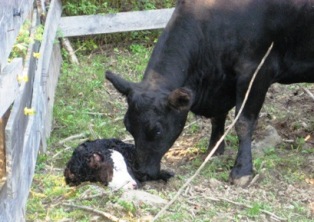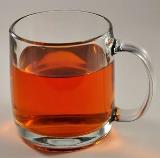Eagle Wood- a great source of protein rich foods
Buy protein rich foods, like meats from Eagle Woods Farms, with confidence as we raise our cattle humanely creating a wonderfully pure tasting beef. It is important to know your food. The first step is understanding the cattle life cycle.
The cattle life cycle encompasses these important factors:
- Genetics
- Husbandry /Feed
- Processing / Slaughtering
Genetics
With assistance from multi-generational farm families, Eagle Wood raises cross breeds of Black Angus and Herefords. This cross breed, we believe, is best suited for our harsh winters and long humid summers where temperatures vary from -25 degrees ºF to 100 degrees ºF with 90% plus humidity. In general this cross breed is calm and gentle reducing injury to personnel and property. Finally the muscle structure is one of the best in terms of taste, leanness and tenderness making these protein rich foods simply wonderful.

Originally from Herefordshire England, Hereford cattle were English bred in the early 1600’s cross breeding large red faced Dutch cattle with small black English cattle. Males typically are red bodied with white faces, bellies and feet. They are large boned. Aberdeen Angus, native to Aberdenshire and Angus counties of Scotland are black bodied, calve easily and have great maternal instincts.
Hereford bulls are calmer than Angus bulls. A bull is a male capable of breeding whereas a steer is a castrated male. At birth our Angus mothers (cows) have an easier time delivering the cross breed calf as opposed to a pure bred Angus calf. This results in a high survival rate for offspring and a longer life for breeding females (cows). A heifer is a female cow that has not given birth. A yearling is a calf between one and two years old.
Husbandry / Feed
Our cattle are born and raised on our farm or neighboring farms depending upon the number being grown. All live on pastures and freely roam the properties.
Our cattle eat no animal by-products, no hormones, and no antibiotic feed (sub therapeutic feeding). New born calves stay with their mothers until weaning and then are placed is a small group of similarly aged animals.
Cattle consume about 90% grass/hay with the balance of wheat/corn silage and multivitamin mix. This mix, based upon our experience, creates a calm animal with wonderfully tasting lean protein rich foods. During the early years on the farms, we tried a mineral block in the pastures but observed that some of the meeker animals refused to go near the block when discouraged by other members of the herd.
Quiet gentle animals are safer to raise and produce better meat. Stressed animals, either physically or psychologically (adrenalin production) deplete glycogen from their muscles. This leads to darkened, tougher meat. This may be a reason why many people refuse to consider beef as a an option for protein rich foods.
What is a ruminant?
A ruminant is a hoofed mammal that chews its cud; which means food is chewed, swallowed and chewed again. Ruminants’ stomachs have three or four chambers. In the first chamber, called the rumen, initially chewed food is mixed with fluid to form a soft mass, the cud, or bolus in the first chamber, the rumen. The animal regurgitates the cud, slowly chews it, swallows it again. The food finally passes through the rumen into the other stomach chambers for further digestion.
We allow cattle to roam and congregate as they like. We have a closed herd. We don’t allow strangers to freely walk with the animals; this reduces physical injury to the public and prevents spread of disease. We leave fields fallow and replant grass and fertilize with our compost to replenish what the grass has taken out of the earth. We compost with wood chips and sell this material to the public taking the burden off our land and reducing the use of chemical fertilizers in the community.
Veterinary Care -
We believe in ethical, appropriate veterinary care. Through the age of 6 months an animal may receive reasonable therapeutic treatment for an illness. It must be prescribed by an independent veterinarian. After six months in age, we determine if an animal stays within our natural sustainable guidelines. If the animal receives treatment it will be removed from the herd. Within the six months we will keep the animal to bring to slaughter at maturity.

When a meat animal from any farm receives treatment before slaughter we should all be concerned about drug withdrawal time. The withdrawal period is the amount of time a drug needs to be eliminated from an animal’s body through sweat, urine and feces. On the rare occasions when veterinary care is needed here, a typical dose of antibiotic for 48 hours has a 5 day withdrawal period. This animal would not be slaughtered for over one year. You can purchase all of our protein rich foods with confidence that you know exactly what is in your beef. During a severe March 2008 snowstorm a Black Angus cow gave birth late at night, became disoriented, and left the calf in a snow field. Early the next morning we found the calf in an ice bank with severe hypothermia. As we warmed the calf it began to cough. Our veterinarian recommended 3cc of injectable penicillin with a withdrawal period of 5 days. This new born will be used for food after 18 months. The calf lives and is in perfect health with his herd. We balance humane treatment with fiduciary responsibility to our families and employees.
Processing / Slaughtering
Slaughtering is the gruesome part of the livestock business. We are humbled that animals give their lives for our nutrition. We treat our animals with dignity and respect.
Animals are killed quickly and in segregated rooms. Numbers are kept to a minimum to reduce stress, reduce danger to employees and to maintain the high quality of all of our protein rich foods including beef and pork.
Animal Stress and Meat
The energy required for muscle activity in the live animal is obtained from sugars (glycogen) in the muscle. In the healthy and well-rested animal, the glycogen content of the muscle is high. After the animal has been slaughtered, the glycogen in the muscle is converted into lactic acid, and the muscle and carcass becomes firm (rigor mortis). This lactic acid is necessary to produce meat, which is tasteful and tender, of good keeping quality and good bright red colour. If the animal is stressed before and during slaughter, the glycogen is used up, and the lactic acid level that develops in the meat after slaughter is reduced producing dark meat which tastes poorer. Lactic acid in the muscle has the effect of retarding the growth of bacteria that have contaminated the carcass during slaughter and dressing. Calm animals provide a good source of protein rich foods.
Hanging Times
On average our steer carcasses hang dry for 7 - 10 days. This period is also called aging, tenderizing, conditioning or ripening. Hanging results in more tender meat with stronger flavor. The meat of a freshly killed animal is very tender. As rigor mortis sets within 24 hours, muscle fibers shorten and meat toughens. At the same time tenderizing begins. Protease enzymes (proteins which accelerate chemical reactions) begin breaking down structural muscle. This is called post mortem proteolysis. Additionally, as fluid evaporates from the meat, flavor becomes concentrated. Similarly, drying fruit concentrates its flavor.
Experienced butchers, at a family owned USDA approved slaughter house, create the retail cuts based upon our customers’ requests and the inherent muscle structure of the animal. All cuts are vacuumed packed, fresh frozen and delivered to our store in Barkhamsted, Connecticut.
Enjoy pure protein rich foods when ordering beef and pork from Eagle Wood Farms.
Products We Use and Trust

Embassy House - organic loose leaf tea







